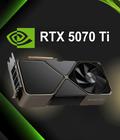Thus far, the GeForce RTX 50-series of cards hasn't quite impressed the critics, especially when compared to how impressive the high-end 40-series cards were. The 5090 performed better than the 4090, but the big price increase compared to the performance uplift made people balk, despite the card being billed as a halo product. The 5080 may have come out with the same MSRP as the RTX 4080 Super, but the performance uplift was scant at best, and the card still couldn't reach the lofty heights of the 4090. None of this mattered, as stock scarcity combined with higher-than-expected prices from the board partners meant that few players actually got a chance to play with the cards. The Nvidia GeForce RTX 5070 Ti enters the market less than a month after the 5080 and 5090, and it comes with an MSRP of $749.99. The question is whether the RTX 5070 Ti is enough to get people excited — if they can find the card.
This is the first card in the RTX 50-series to not receive a Founders Edition model. We received the ASUS Prime Triple Fan version of the RTX 5070 Ti, which is a non-overclocked variant yet still has a switch for both quiet operation and a more performance-oriented operation. It didn't make much of a difference when it comes to fan speed because the card is still quiet under load. The card has a metal backplate, but the shroud is still made of plastic. It's a light card because of it — light enough that ASUS didn't feel the need to bundle the card with a stand, like it did with the 4070 Ti Super. One interesting thing about the card is that it features no RGB lights whatsoever, so even though it is a 2.5-slot card, it fits the aesthetic for someone who wants a non-flashy GPU for their system.
As one would expect, the specs for the 5070 Ti are lower than the 5080. It has a CUDA core count of 8960 instead of 10752, a boost clock of 2.45 GHz instead of 2.62GHz, and a slightly lower core count all around, but it also means that the 5070 Ti uses less wattage than the 5080. Both cards have 16GB of GDDR7 VRAM, which is good since more games want more VRAM for their textures, and there's no guarantee that every developer will use Nvidia's texture compression technology to keep memory usage under control. As for power supplies, the recommendation is 700W, which is what the 4080 Super needed when that card was released last year.
Like the other cards released in the 50-series so far, the focus isn't on raw performance but on AI features. The first is DLSS 4, which promises to be a significant upgrade over every other version of the AI technology to date. The main concept is still the same, where the technology has the game run at a lower internal resolution before using the card's tensor cores to upscale the image so it looks like a good facsimile of the target resolution. This time, the focus is on image clarity, where ghost images are eliminated and finer details like chain link fences, thin foliage, and power lines look clear and smooth instead of jagged or noisy. For the most part, this works quite nicely. Small on-screen movements don't produce odd-looking images, and the shimmer associated with fine details is reduced to the point where you have to lean into the screen to see that something's amiss. There are still some instances of shimmering and noise, but you'll really have to hunt for those anomalies to see them. You also have to use the technology when targeting the monitor's native resolution, as going for anything lower like using a 4K monitor with a 1440p target resolution has a tendency to produce graphical anomalies that don't exist if you're targeting 1440p on a 1440p monitor.
The second thing is multi-frame generation. DLSS 3 used AI to generate an extra frame of visual data to make games look smoother. DLSS 4 goes the extra step by letting you create up to three more frames of AI-generated screen data to create what you can perceive as a higher frame rate experience. This creates some extra latency in games, and while Reflex 2 is supposed to mitigate that, the feature isn't out yet. The amount of latency can be determined by the game's base frame rate at that upscaled resolution, and the fear is that the lower you go down the card stack, the higher the latency penalty.
At the moment, your opinion of DLSS 4's multiframe generation is going to be dependent on several factors. The known latency penalty is enough to dissuade someone from using the technology in online play, but we did use it in Marvel Rivals to see it in action, and it was fine there. It helped that the game's base frame rate was high enough that the latency penalty would only be noticeable to the most hardcore of players. It also helped that we used a gamepad instead of a keyboard and mouse, as the gamepad tends to hide the latency. We also tried multiframe generation on Alan Wake 2 at 4K with ray tracing on, and this is where the latency starts to be more noticeable, since the base frame rate at these settings is far less than 30fps. Even with a gamepad and frame generation set to 4X, the game started to feel sluggish when trying to turn the camera at a fast speed. It was a bit better than what you got on the 4070 Ti Super with frame generations set to 2X, but it is noticeable. The Reflex 2 tech really needs to arrive and work as advertised before the cards with lower specs have a chance of using it properly.
The good news for Windows users is that NVIDIA has a solution for getting some of this new AI-related technology into games that still use the old versions of RTX technology. The new version of the Nvidia App has driver level overrides that add some of the technologies like multiframe generation and the new transformer model of DLSS, to name a few. The good news is that some of the features are available to older RTX cards, but not everything is available due to the lower tensor core count of those older cards. The bad news is that the application doesn't cover everything, as Nvidia has to essentially whitelist a game in the app to use those driver override features. It also doesn't help that the latest version of the Nvidia App doesn't have user-friendly names for the settings, so you'll need to hunt down information online to realize that Option J is what you'll need to activate the brand-new technology.
The PC we're using for these tests is a Ryzen 7 7700X equipped with 32GB of G.Skill Flare X5 Series DDR5-6000 RAM in a dual channel configuration. The motherboard is the MSI B650-P Pro. We're using Windows 11 version 24H2, and the Nvidia press driver is version 572.43. Testing is split between 1440p and 4K resolutions, but the list of titles tested has been reduced due to time constraints and the fact that some of the tools we use for measurements have been malfunctioning with the 5070 Ti. Unless noted, all of the graphical settings were placed at their maximum individual levels instead of relying on presets, and DLSS upscaling was always set to Quality or Ultra Quality. Tests were also conducted using the game's built-in benchmarks. As always, we recommend using this review in conjunction with others that may have a wider selection of cards to test with to get a clearer picture of where this card stands overall.
3DMark
As always, we start off the benchmark portion of the review with the 3DMark suite of synthetic benchmarks. In Fire Strike, the 5070 Ti scores 46454 at 1080p, 30717 at 1440p, and 17627 at 4K. The differences between the 5070 Ti's scores and the scores achieved on the 4070 Ti Super start to shrink as you go up in resolution, but they're still significant. In Time Spy, the 5070 Ti nets a score of 23684 at 1440p and 11484 at 4K, with the uplift over the 4070 Ti Super shrinking further. Port Royale shows a bigger lead similar to what was seen in Fire Strike, but the uplift differences shrink again once you go to Speed Way and Steel Nomad. What makes this interesting is that this compares very favorably against the 4080 Super. As stated in the 5080 review, I no longer have access to the 4080 Super for testing, but if you compare the benchmarks from last year, the 5070 Ti goes between going a little below the 4080 Super in these tests or nudging a little past it in the scores. Even though these are just synthetic tests, this bodes well for the 5070 Ti overall.
Red Dead Redemption II
Red Dead Redemption II is the oldest game in our benchmarks, but it is still considered heavy enough to be a good benchmarking title. At 1440p, the 5070 Ti scores an average of 97fps with a 38fps low, and that jumps to 108fps with a 37fps low when DLSS is activated. At 4K, the average frame rate hits 70fps with a 41fps low, and DLSS brings that to 85fps with a 39fps low. That's between a 9%-15% increase over the 4070 Ti Super's numbers, while falling between 5%-7% below the 2024 numbers of the 4080 Super.
Horizon Zero Dawn Remastered
With Horizon Zero Dawn rebuilt using the same engine as Horizon Forbidden West, performing a benchmark should provide a good idea for how both games will perform on this card. At 1440p, the 5070 Ti scores an average of 141fps, and that gets raised a bit to 147fps with DLSS, while frame generations boosts that further to 236fps. At 4K, the 5070 Ti hits an 88fps average, while DLSS boosts that to 115fps and frame generation bumps that to 136fps. Compared to the 4070 Ti Super, that's between a 5%-13% boost in performance.
Final Fantasy XIV Online: Dawntrail
The benchmark goes through parts of the MMO in a cinematic fashion, and the only knock against it is the fact that you can't turn off either FSR or DLSS. At 1440p, the 5070 Ti scores an average of 163fps with a low of 85fps making for a 3.7% uplift over the 4070 Ti Super. At 4K, that jumps to a 9.9% difference as the 5070 Ti scores an average of 95fps with a 63fps low. That may not be a significant difference so far, but it remains impressive since the 5070 Ti has a lower MSRP than the 4070 Ti Super did.
Avatar: Frontiers of Pandora
Ubisoft's title isn't the newest iteration of the Snowdrop engine, but it is still valuable as a title that always runs ray tracing and one that only relies on FSR for frame generation. It is also a weird title in that it actually shows some degradation when using DLSS. At 1440p, the 5070 Ti gets an average of 94fps with a low of 75fps. That drops to 90fps on average with a 73fps low with DLSS on, but using FSR3 with frame generation brings the numbers back to 146fps on average with a 109fps low. It's a decent increase over the 4070 Ti Super's numbers while also falling slightly below what the 4080 Super produced. In 4K, the 5070 Ti hits an average of 54fps and drops to 42fps with DLSS but becomes more playable with FSR3 and framegen as it hits 89fps. Interestingly, it bests the old 4080 Super numbers, most likely due to the increased number of tensor cores helping out with the ray tracing.
Black Myth: Wukong
This game is heavy to the point where you can't max out everything and run at the native 4K resolution without some sort of resolution scaling. Unlike many other games, Black Myth: Wukong has no presets, as it prefers to set a good number of its graphical options with percentages. Luckily, those percentages give you some hints on naming conventions.
At 1440p with TSR set to 100%, the 5070 Ti hits an average of 49fps with a low of 43fps. DLSS at 75% brings the numbers up to 70fps with a 57fps low, and frame generation takes things to a 105fps average with a 93fps low. Turning on ray tracing drops numbers low enough that you'll need frame generation to hit an 88fps average. The jump to 4K tells the same story as frame generation is absolutely necessary to hit playable levels, especially if you're planning on using ray tracing.
Cyberpunk 2077
Cyberpunk 2077 happens to be a title with just about every graphical option available. It also remains one of the more taxing games when it comes to the various forms of ray tracing. The different configurations are plentiful enough that it becomes the perfect title to test every graphical feature any video card can offer up.
At 4K with no ray tracing whatsoever, the 5070 Ti barely makes it to playable territory with an average frame rate of 36fps and a 30fps low. The card needs DLSS to take the game over 60fps, and using frame generation takes the card to pretty high frame rates with a latency penalty that isn't too bad if you're using a gamepad to play. Throw ray tracing into the mix, and you'll need at least 2X framegen to get things to a playable state, and that is especially true if you're going for path tracing. While you can still get away with a decent amount of latency if you're using ray tracing and multiframe generation, doing so with path tracing isn't ideal unless the upcoming Reflex 2 technology can make things better.
Monster Hunter Wilds
Monster Hunter Wilds is a new entry to the list thanks to the standalone benchmark being released ahead of the full game. One thing that this benchmark doesn't take into account are 1% lows, so that isn't being charted. At 1440p, the RTX 5070 Ti hits an average of 88fps, a 12% uplift over the 4070 Ti Super. Using DLSS brings the frame rate of the 5070 Ti up to 100fps, and that goes to 143fps when frame generation is activated. Throw in ray tracing, and the drop isn't that bad; the 5070 Ti hits 79fps compared to 71fps for the 4070 Ti Super. Throwing in DLSS has the 5070 Ti go up to 93fps, and frame generation takes the card to 136fps. Overall, you're looking at anywhere between an 8% to 15% uplift against the 4070 Ti Super. The story is the same at 4K, where uplifts of the 5070 Ti over the 4070 Ti Super range from 12% to 16%, but both cards need at least DLSS with and without ray tracing activated to get above 60fps.
The immediate conclusion after these tests is that the 5070 Ti is a legitimately good card. The uplifts compared to the 4070 Ti Super range from small to decent, but it's doing this at a lower MSRP, which makes it impressive. When checked against the old, limited data we have for the 4080 Super, the 5070 Ti can get fairly close to and even beat that card's numbers in certain circumstances. One interesting wrinkle is that, according to other outlets, the 5070 Ti has a good deal of overclocking room available. Some critics have reported that they've been able to get enough of an overclock going that it matches up with some of the OC variant cards. In some games, the overclock is enough to get the card closer to what the 5080 offers in performance. For those looking to save some cash, going with an MSRP model looks tempting if you're not afraid of messing with some overclocking tools.
None of this matters due to the prices that almost all video cards seem to be going through right now. For those aiming for the 5070 Ti, the lack of a Founders Edition means that your only choices come from the board partners, and those prices are way above MSRP. A quick look at Micro Center shows that the cards are scheduled to launch anywhere between $899 to $1010, and every other retailer has followed suit. Some retailers are implementing a lottery system to buy the cards at those relatively high prices. If you were aiming for the 4070 Ti Super, things are worse, as those cards have skyrocketed to range from $899 for an out of stock model to just under $1,500 — way above the card's original $799 MSRP. This is compounded further if you're looking for anything above that, such as a 4080 Super, which is now hitting the same price point as the 4070 Ti Super. Whether this is a result of people trying to go all-in on AI, the tariffs, a halt in manufacturing for previous-generation cards or something else entirely, it seems like we're reliving the nightmare crypto boom scenario. GPUs are going to be overly inflated in price, and consumers who actually want to buy these cards to play games can't win.
There is one factor to consider: AMD's upcoming Radeon cards. With the news that AMD isn't aiming for the high-end graphics card market, comparing their previous high-end models with the RA 7900 XTX against the RTX 5090 and 5080 didn't seem prudent, and reviews from other outlets show that this was the right call, as that card performed fine in rasterized graphics but got demolished in ray tracing. Their quality of FSR 3.1 wasn't up to snuff with DLSS 3, let alone the new DLSS 4 features. The RX 9070 XT is set to launch next month, and their CES charts would lead you to believe that they'd be aiming to compete directly against the RTX 4070 line, now superseded by the 5070 duo of cards. The main things people will be looking for are performance, price, and availability. If AMD can hit all three areas at a price point that is appealing to consumers, then Nvidia will have a real fight on its hands.
It is very difficult to recommend the Nvidia GeForce RTX 5070 Ti at this moment. The card is quite good, as it easily bests the 4070 Ti Super, and other outlets suggest that overclocking can bring this card to the level of a 4080 Super. In a normal world, this would be the sweet spot for those looking to get into good 4K gaming without having to drop any settings. However, the current prices of the video cards significantly hamper any excitement one may have for this card — and perhaps other cards for a while to come. If you can somehow find the 5070 Ti at MSRP and haven't done an upgrade in a while, then it's a fine purchase because of the performance combined with other RTX-related features that mostly work as advertised. Otherwise, you'll want to hold off until prices stabilize and see what the AMD card will offer.
Score: 6.5/10
More articles about NVIDIA Geforce RTX 5070 Ti











 Powered by the NVIDIA Blackwell architecture, fifth-generation Tensor Cores and fourth-generation RT Cores, the GeForce RTX 50-series delivers breakthroughs in AI-driven rendering, including neural shaders, digital human technologies, geometry and lighting.
Powered by the NVIDIA Blackwell architecture, fifth-generation Tensor Cores and fourth-generation RT Cores, the GeForce RTX 50-series delivers breakthroughs in AI-driven rendering, including neural shaders, digital human technologies, geometry and lighting.










